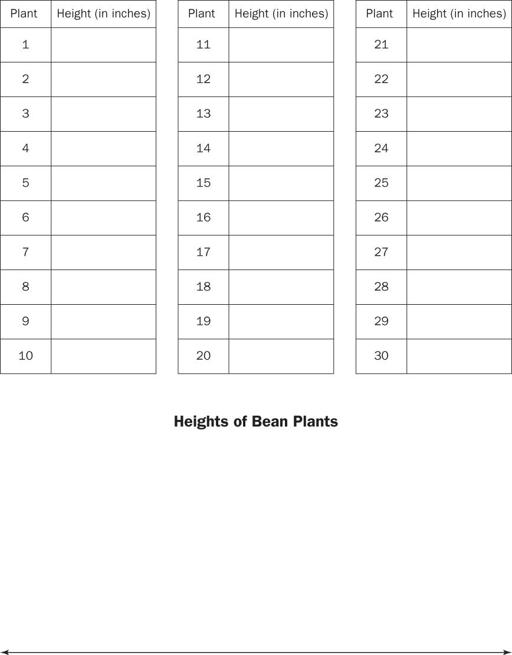Teaching the Common Core Math Standards With Hands-On Activities, Grades 3-5 (84 page)
Read Teaching the Common Core Math Standards With Hands-On Activities, Grades 3-5 Online
Authors: Judith A. Muschla,Gary Robert Muschla,Erin Muschla-Berry
Tags: #Education, #Teaching Methods & Materials, #Mathematics, #General

BOOK: Teaching the Common Core Math Standards With Hands-On Activities, Grades 3-5
10.7Mb size Format: txt, pdf, ePub
5.
After your students have completed their line plots, pose questions such as the following:
- What is the height of the tallest plant?
 What is the height of the shortest plant?
What is the height of the shortest plant?
- What is the difference between the tallest plant and the shortest plant?

- If the height of the tallest plant was divided by 2, how tall would the plant be?

- What height appears most in the line plot?
 If a plant of this height were to double in size, how tall would it be?
If a plant of this height were to double in size, how tall would it be?
- Find the sum of the heights of the three shortest plants.

Closure
Discuss students' line plots. Ask: How does this line plot help you to understand the data?
Answers
Heights of Bean Plants
Note:
Following are some suggestions should you decide to have students grow bean plants and measure their heights.
If you decide to do this, plant the seeds about three weeks before assigning the activity.
This will give them plenty of time to germinate and grow. Students may record the heights of the bean plants on reproducible, “Bean Plant Growth Class Data.”
Materials (for growing bean plants)
Bean seeds; 14- to 16-ounce plastic cups (clear cups will allow students to see the root system of their plants); small plastic plates on which to place the cups; enough potting soil to fill each cup to about 1 inch from the top; water; an area where plants will receive sunlight; rulers with a-inch scale; reproducible “Bean Plant Growth Class Data” for each student.
Some tips for growing the plants:
1.
Poke a few holes in the bottom of each cup for drainage, then fill the cup with potting soil about 1 inch from the rim of the cup. Place the cup on the plastic plate and provide water until the soil is moist.
2.
Place seeds in the cups, one seed per cup. The seeds should be planted about 1 to 1inches deep in the soil. Cover the seeds with soil. Press the soil down firmly but gently.
3.
Place cups along with their plates on a window sill (or other area) where they will receive ample sunlight.
4.
Water the seeds regularly to make the soil moist, but not so much as to saturate the soil.
Bean Plant Growth
Bean Plant Growth Class Data
Other books
Rex Regis by L. E. Modesitt Jr.
Simply Divine by Wendy Holden
Rama Revelada by Arthur C. Clarke & Gentry Lee
Say the Word by Julie Johnson
The Roominghouse Madrigals by Bukowski, Charles
Search the Seven Hills by Barbara Hambly
The Book of Lost Fragrances: A Novel of Suspense by M. J. Rose
The Engagement Deal by Kim Lawrence
Wizard: The Life and Times of Nikola Tesla by Seifer, Marc
Doctor Who: The Leisure Hive by David Fisher



